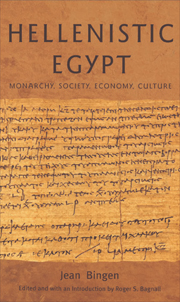Book contents
- Frontmatter
- Contents
- Original Sources of Chapters
- List of illustrations
- Glossary
- Maps
- Foreword
- Introduction: Jean Bingen and the currents of Ptolemaic history
- Part I The Monarchy
- Part II The Greeks
- Part III The Royal Economy
- Part IV Greeks and Egyptians
- Conclusion
- Bibliography
- General index
- Index of passages discussed
- HELLENISTIC CULTURE AND SOCIETY
Conclusion
- Frontmatter
- Contents
- Original Sources of Chapters
- List of illustrations
- Glossary
- Maps
- Foreword
- Introduction: Jean Bingen and the currents of Ptolemaic history
- Part I The Monarchy
- Part II The Greeks
- Part III The Royal Economy
- Part IV Greeks and Egyptians
- Conclusion
- Bibliography
- General index
- Index of passages discussed
- HELLENISTIC CULTURE AND SOCIETY
Summary
‘Hellenistic Egypt’, though an apparently unproblematic pair of words, is in reality a troubling combination. It corresponds to a tiny slice of Egypt's history, barely three hundred years. After having been an isolated and passive unit in the larger entity of the Achaemenid empire, Egypt became, by virtue of its economic potential and human density, the lever of the power that a dynasty arriving from the north tried to exercise in the Eastern Mediterranean from Alexandria, and then the basis for the dynasty's survival. During these three centuries, a long span by the standards of the other Hellenistic kingdoms, the country was directed from this city, a nearby but foreign world. From Alexandria, the Ptolemies could look to the east, the north or the west while organising and exploiting the south. Once one sets aside the dynamics of the first few reigns, however, this period looks in its unfolding like a transition – like all periods in human history, to be sure, but still leading us to ask in what areas this transition prepared, or failed to prepare, new dimensions for Egypt. By way of Alexandria and then of Fostat, indeed, Egypt was to become an integrated element in a much larger whole, first the Roman empire, then the Christian Byzantine East, and finally the Islamic world.
On our conventional time-scale, the Hellenistic period begins when a military migration, revolutionising the Greek practice of warfare, emerged from the southern Balkans and destroyed the Achaemenid organisation of the East while at the same time trying to assimilate it, for better or worse. Egypt was a peripheral part of this process, and submitted to the Macedonians without resistance. Ptolemy Soter made it the central and largest part of his kingdom. He also initiated a significant innovation, the permanent installation in Egypt of a foreign population, significant in number, given a controlling role, and the source of dynastic stability.
- Type
- Chapter
- Information
- Hellenistic EgyptMonarchy, Society, Economy, Culture, pp. 279 - 289Publisher: Edinburgh University PressPrint publication year: 2007



